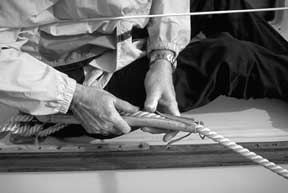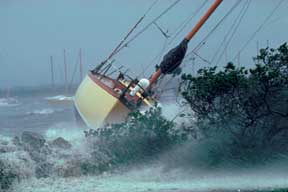
Don’t wait until it happens; get your boat ready now
My first memory, as a small child, was being in the middle of a hurricane in the North Atlantic. It was the 1930s. Our family was returning by ship from a European vacation in the days before radar and weather satellites. One day before arriving in New York, we blundered into a hurricane that was moving up the East Coast. Portholes were knocked out of the side of the ship, and our deck was awash with about two feet of water in which our suitcases sloshed about in our cabin. The ship almost didn’t make it. At the New York pier, dozens of ambulances were waiting for passengers who had broken arms and legs or skull fractures.
June of each year marks the official beginning of the hurricane season. Even though most hurricanes spawned in the tropics don’t find their way to our shores, strong cold fronts and their associated thunderstorms can also have devastating winds – frequently of hurricane strength. No matter where you live, storms are a fact of life. While our property on land is vulnerable to the winds and storm surge, our floating property is even more vulnerable.
If you heard a radio announcement that a major storm would hit your area within 24 hours, would you have a plan of action for taking care of your boat? The majority of boatowners don’t. The time to plan for the onslaught is not when you hear the announcement; the time is now.
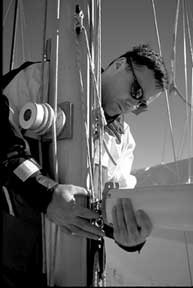
Removing the boom to reduce windage
Sunny-day preparations
Many precautions can be taken when the weather is clear and calm. Begin by checking that your deck-cleats are adequately through-bolted, with substantial back-up plates. Are the cleats large enough to take large-diameter storm lines, with more than one line on the same cleat? Will the chocks handle these storm lines when they’re encased in chafing gear? Do you have large-size mooring lines made up to the proper length with eye-splices that will fit your cleats? Do you have fenderboards if you will be tied to a dock or canal wall? All these chores take time, and when a storm is approaching, time is one thing that’s in short supply.
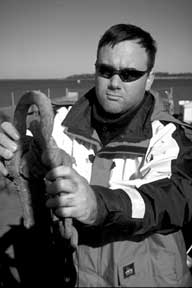
Checking the mooring
When that storm is expected
On sailboats, one of the most important things is to reduce windage by removing all the sails, especially roller-furling headsails, and certainly the dodger. Even seemingly innocuous halyards create wind resistance. A 1/2-inch halyard going to the top of a 50-foot mast presents 4 square feet of resistance to the wind. Booms that can be easily removed can be stowed in the cabin. On small sailboats, unstepping the mast is a good idea. Anything on deck that can’t be removed should be lashed down firmly. Vulnerable antennas should be taken off, and plastic compass and instrument gauge covers should be removed or secured with duct tape.
If it is at all possible, boats should be removed from the water and stored on land. An MIT study after Hurricane Gloria found that boats stored ashore were far more likely to survive than boats in the water. If a boat is stored on land it should be well above any possible storm surge and not stored in high-rise storage racks.
You have to prepare for more than the wind. In tidal areas, the storm surge – that sudden rise of water level due to the combination of low pressure and onshore winds – is usually responsible for most of the damage. In addition, open boats must take into account the huge amounts of rainfall that accompany hurricanes, nor’easters, and thunderstorms. Is your open cockpit self-draining with nothing loose that can clog the drain? On boats without self-draining cockpits, is the battery charged so that the automatic electric bilge pump can handle the job?
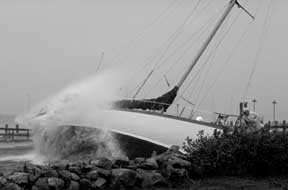
Hurricane Gloria in 1985
Hurricane holes
Rivers and man-made canals usually provide good “hurricane holes” if the boat must remain in the water. In natural hurricane holes, the shallower the water where the boat is anchored, the better, since this provides a better scope ratio for your anchor line. The bottom composition is of great importance, with a sandy bottom giving the best anchor set. Survey the shoreline around a hurricane hole. If your boat should drag, will it end up on a sandy beach or on the rocks?
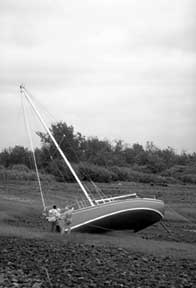
Aftermath of Hurricane Edouard in 1996
If there is no time to find a snug harbor and your boat has to weather a storm at anchor, the best anchoring bottoms, in descending order of holding, are: sand, clay, hard mud, shells, and soft mud. Needless to say, the larger the anchors and the more anchors deployed, the better. A BoatU.S. test found that embedment type anchors – those that are screwed into the bottom – are the most likely to hold.
Boats in canals usually survive better than boats at a marina, provided they’re tied properly and protected from pounding canal bulkheads. A boat kept in the middle of a canal has the best chance – however this requires cooperation from property owners on both sides of the waterway. During Hurricane Andrew, one boatowner tied his 26-foot powerboat in the center of a canal using eight 3/4-inch lines, creating a spider web, with his boat as the spider in the center. The boat survived without a scratch. Boats fastened to the bulkheads of canals didn’t fare as well, due to pounding from wind and waves. If you plan to moor your boat in the middle of a canal, remember that this can block access to others who have yet to arrive, so the final tieup probably cannot be done until the last minute.
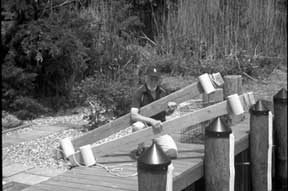
More fendering
Boats secured to a canal bulkhead should employ additional fendering. Usually inflatable fenders just don’t do the job, since it’s impossible to keep them at the right location, and they frequently collapse from pressure or abrasion. It’s a better idea to make up fenderboards well in advance, so they can be hung on the sides of the boat to help protect it from pounding. In addition, one or more anchors deployed out into the waterway will help take some of the strain off the fenders.
One of the biggest problems when a boat is kept at a bulkhead or in a marina is the boat’s hull rising above short bulkhead pilings due to the unusually high water level during the storm surge, from the wave action, or from both. When this happens, the boat is frequently impaled on the piling. Properly installed floating docks make fendering and mooring easier. Pilings high enough to be well above the rubrail of boats during the height of the storm surge are a necessity. Wide slips, with pilings at their outer ends, are also a big advantage in securing a boat that must weather the storm in a marina.
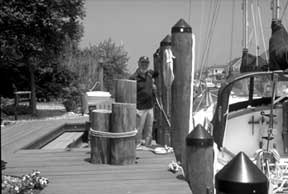
During one nor’easter the rubrail of his schooner was just two feet from the top of his dock pilings
In a slip or at a dock, the bow of the boat should face in the most unprotected or open-water direction since this offers the least wind and wave resistance and reduces the chance of waves flooding the cockpit. Boats that have bow-eyes to winch them onto a trailer should make use of them as a strong fastening point. Dockline lengths must be long enough to allow the boat to rise to the maximum-expected storm surge (or beyond) and to make it possible to run mooring lines to the farthest point possible. Unfortunately, long line lengths usually mean that a boat in a confined slip has a good chance of rubbing the pilings due to line stretch. Fenderboards are a big help in this situation.
All cautionary material written about storm survival stresses that you should not try to ride it out on your boat if going ashore is an option. I certainly would not suggest that staying with your boat at a marina – even if allowed – is a good idea. Having said that, I must say that twice I have done just that. When Hurricane Belle moved up the East Coast in 1976, I tended the docks at a New Jersey yacht club where my boat was berthed. I adjusted and moved lines on my boat as well as those on other boats I could get to until the storm surge and waves began washing over the docks. Six boats at the yacht club went to the bottom, but my boat survived without a scratch.
In September of 1985, my son, Tom, and I tended lines and weathered Hurricane Gloria aboard our schooner in a slip in a marina off Barnegat Bay on the New Jersey coast. On both of these occasions, line tending and adjusting prevented our boat from sustaining any damage.
Nylon mooring lines
When a big blow is moving your way, large diameter lines should be installed in place of, or in addition to, the normal mooring lines.
Nylon mooring lines are the material of choice, since they provide both strength and a shock-absorbing effect against sudden strains. The downside of this shock-absorbing protection is that these nylon lines s-t-r-e-t-c-h. At a mere 200 pounds of force, a 1/4-inch line, 20 feet long, can stretch four feet or more. Under the same force, a 1/2-inch line of 20 feet will stretch only about one foot. The rule of thumb is that a good-quality nylon line will stretch 25 percent of its length at 50 percent of its breaking strength. This stretch factor must be taken into account when you are setting up storm lines so that the stretch caused by wind and wave pressure won’t allow the boat to pound the dock, the pilings, or an adjoining boat. Remember, larger diameter equals less stretch. Double the diameter and you cut the stretch to one-quarter (the stretch is inversely proportional to the square of the diameter). Also, larger-diameter lines are less likely to fail from chafing.
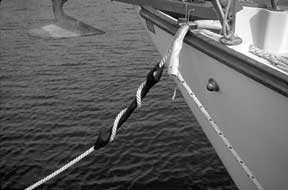
An unexpected finding by MIT after Hurricane Gloria showed that many nylon lines that were angled across a chock failed internally when the core melted from the friction created by repeated stretch cycles. Most high-quality nylon lines are treated with a lubricant to reduce this type of failure, but this lubricant dissipates with the aging of the line. Another little-known quality of nylon line is that when wet it loses about 15 percent of its strength (which returns when the line has dried out). Since we are most concerned with strength during storm conditions – when the line is wet – this is another item to factor into the equation of storm-line size. It’s also important to know that for lines of equal diameter, a braided line has more strength than a 3-ply line, and colored line has slightly less strength than fibers that have been left natural.
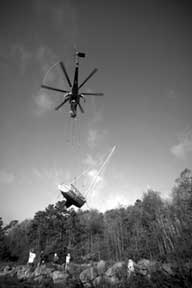
After Hurricane Bob in 1991
Mooring precautions
For those boats that weather a storm on a mooring, there are special considerations. Most yacht clubs and marinas prescribe the equipment used on a permanent mooring, so the underwater portion of a mooring is usually beyond the control of the boatowner. However the pendant, or pendants (there should be at least two) – from mooring to boat – should be checked carefully. Since they go through the bow chocks at a sharp angle, they are especially subjected to stress and abrasion, and extra chafing protection is necessary.
When Keith and Gloria Lyman had their boat on a mooring in the Hudson River during a nor’easter, it broke away and went on the rocks. “Although the mooring and pendants were in good condition, there were sharp corners on the bow chocks that eventually sawed through the chafing gear and pendants,” Keith recalls. As a chafe-preventer, heavy canvas is good insurance. Plastic or rubber hose is not as good because it can cause the mooring line to overheat.
This brings us to the question of nylon line quality. There is a wide range of nylon lines, with the cheaper nylon stretching more and having considerably less abrasion-resistance and internal lubrication – so don’t skimp here. It’s much cheaper buying high-quality line than buying a new boat. Insurance companies estimate that up to half of the boat damage due to Hurricane Andrew, which hit Florida in August 1992, could have been prevented with adequate docklines. Unfortunately, no matter how well you protect your own boat, frequently it’s the careless boatowner near you whose boat is poorly tied or breaks loose who can be the cause of your damage. When one boat damages another under these Act-of-God catastrophes, insurance companies seldom hold one owner liable for damage to another’s boat. The damage to your boat from the negligence of another owner is the same as if it were your own fault.
To help prevent the problem of inadequately tied boats, many marinas and yacht clubs specify minimum line diameters for docklines. It’s a rule designed to counter stupidity. It wouldn’t hurt to encourage this policy in all marinas and yacht clubs, and boatowners should see to it that it is enforced for their own protection. A corollary to this rule should be the requirement of larger-sized and additional lines when a storm is predicted.
For sailboat owners, there is another consideration. When sailboats are in adjacent slips there is the possibility that the boats will roll “out of sync” and as they do that their masts and rigging will foul each other. These impacts can eventually break shrouds and drop a mast on deck, in the water, or on another boat. It would be nice if there were always a powerboat in slips between sailboats to prevent this from happening, but it’s not a perfect world.
Roller-furling jibs
The worst knockdown we’ve ever had – a 90-degree one – occurred several decades ago in the relatively benign waters of the Intracoastal Waterway. With a thunderstorm approaching, we anchored our 26-foot sloop off-channel and battened down the hatches. I took special care to furl our roller-furling jib as tightly as possible – so tight, in fact, that there were not enough turns on the furling drum to roll it up completely. This left a handkerchief-sized section of jib out. When the squall-line of the thunderstorm hit, the winds, as measured on shore, clocked over 75 mph – hurricane force. We were safely inside the cabin when suddenly we heard a loud “snap,” and our world turned sideways. The wind had grabbed the small section of jib, and the plastic clam-cleat that held the furling line was unable to hold. The furling line ran through the cleat, melting all the teeth, and the genoa came out fully.
What had we done wrong? First, there should have been enough turns on the furling drum to allow the jib to be tightly and completely furled, with two or three turns of jib sheets to complete the job. Second, although clam cleats are frequently convenient while sailing, they should not be relied on in storm situations. A few years later we observed the same thing happen to another boat in the yacht club where we were weathering Hurricane Belle. Although we survived the hurricane with no problems, the boat whose genoa unfurled at the height of the storm sustained severe damage.
We may have a very calm season, but if The Big Blow comes, will you be ready?
Article from Good Old Boat magazine, May/June 2002.


